NVIDIA's GeForce GT 430: The Next HTPC King?
by Ryan Smith & Ganesh T S on October 11, 2010 9:00 AM ESTPower, Temperature, & Noise
We only have 1 GT 430 card on hand, so unlike past articles we cannot compile any data on the load voltages of this line of cards. Our lone Asus card has a load voltage of 1.08v, and an idle voltage of 0.88v. Idle clocks are 50.6MHz for the core, and 270MHz effective for the memory.
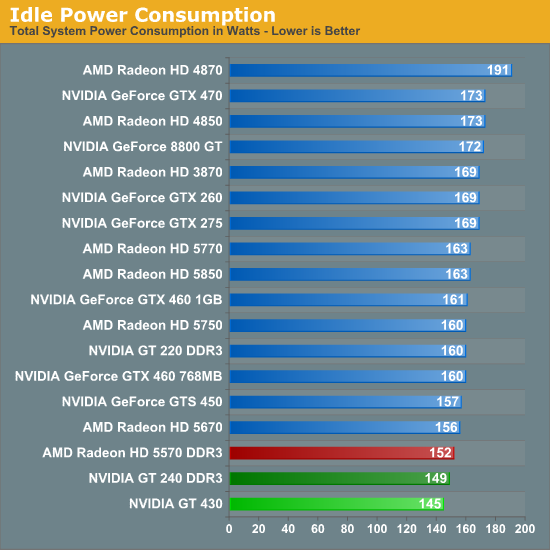
While GT 430 may not be competitive on a performance-per-dollar basis, it’s hard to argue with these power results. Even at these low wattages where our 1200W power supply isn’t very efficient, the GT 430 still delivers an idle power consumption level 7W under the Radeon 5570, and an even larger 11W advantage over the otherwise performance-superior Radeon 5670. We can’t measure the card’s actual power consumption and NVIDIA does not provide a reference level, but the GT 430 can’t be drawing more than a couple of watts here.
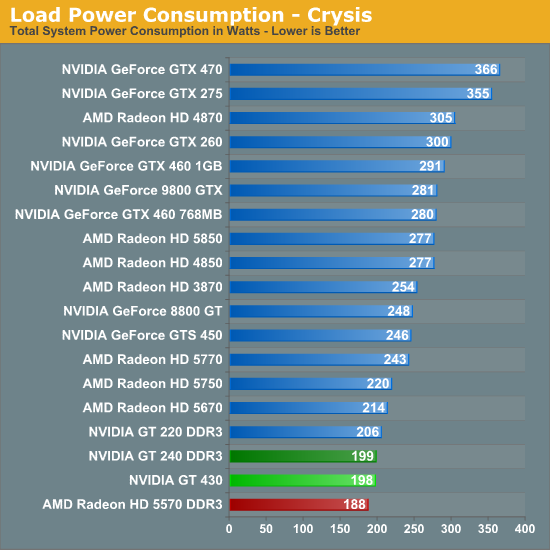
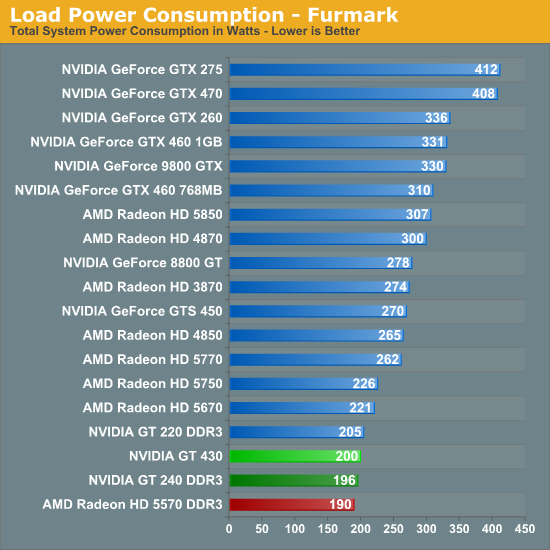
Under load things are less rosy for the GT 430. Under Crysis it ends up drawing 10W over the 5570, which serves as yet another testament to the amazing level of performance-per-watt that AMD has been able to attain; remember that the 5570 had better performance at the same time. Under Furmark the situation is just as bad, but at this point we’re looking at a more pathological case. Overall 10W isn’t going to break the bank in an HTPC (especially since these cards would rarely get up to full clocks in the first place) but it’s something to consider if every watt is going to count.
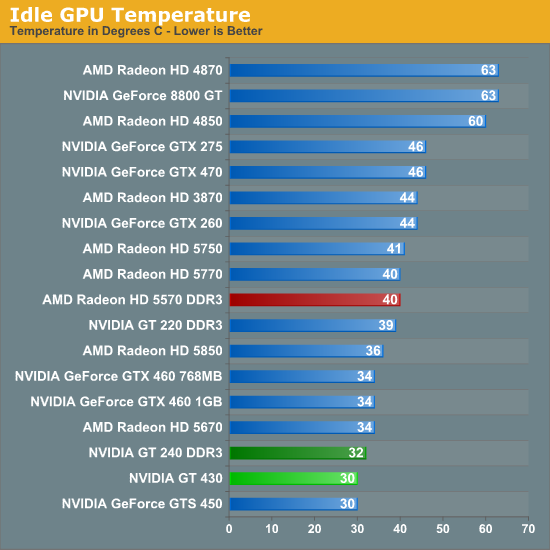
When it comes to idle temperatures, the GT 430 is second to none. With the card only consuming a couple of watts at idle in the first place, its idle temperatures are barely above room temperature (and even closer to ambient case temperatures). It’s tied with the GTS 450, which impressed us last month with its highly capable cooler. Meanwhile our 5570, which is a low-profile card just like the GT 430, ends up being a good 10C higher. AMD’s higher idle power consumption directly translates to a higher idle temperature.
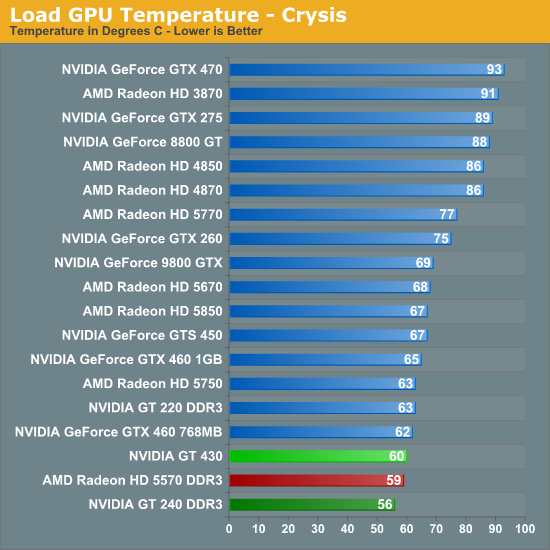
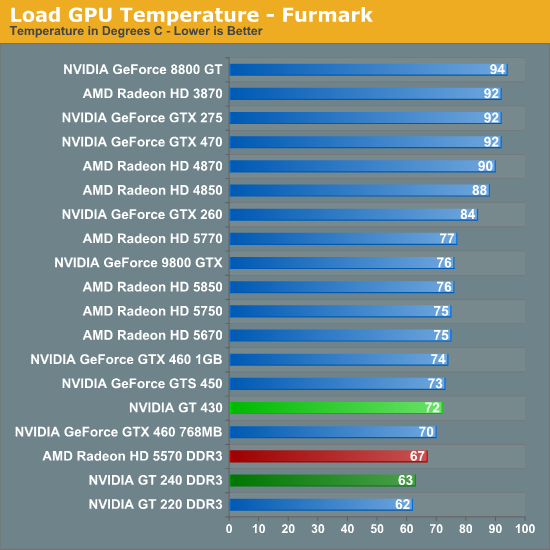
Looking at load temperatures, these results aren’t all that surprising given the cooler in use. The Asus cooler is practically a passive cooler, as the small fan is not capable of moving much air (though it is unusual to not see Asus aggressive on cooling). As a result it manages to reach higher temperatures, but we’re still only talking about 60C under Crysis and 72C under Furmark. This is worse than the 5570 and its larger fan by a bit, but not significantly so.
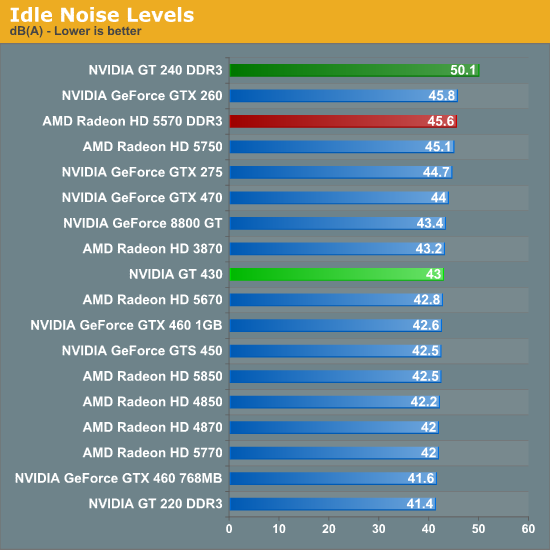
At idle the GT 430 is consistent with our other cards. With the exception of a couple ridiculous cards like our GT 240 and in this case the 5570, everything is at roughly 42-44dB(A). The 5570 is more fan than heatsink, which is likely why it has such a poor showing here compared to the GT 430.
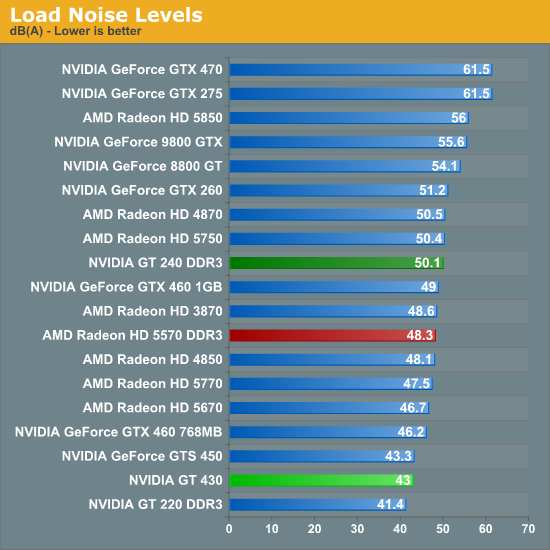
The payoff of accepting higher temperatures is less noise to contend with. The GT 430 never needs to ramp up its fan in our tests, delivering a load noise level even lower than the GTS 450, and only worse than a GT 220 that runs up against ambient noise levels. If you want to make a good HTPC card then it needs to be silent, and Asus/NVIDIA have delivered on that here. It’s not quite silent since it’s not passive, but it’s about as close as one can reasonably achieve. It’s also noticeably better than the 5570, a card which is by no means noisy. If noise is a primary concern then the GT 430 is a very good candidate for a HTPC.










120 Comments
View All Comments
esc923 - Monday, October 11, 2010 - link
Well you answered which means you do care, which is why I fully agree when you say that you could care less how smart anyone thinks you are.I'm not going to bother with reasoning out your obsession with video game FPS as the main 'objective' measure of an HTPC card while dismissing all else, as it's lost on you. Instead, let's try it the man no way instead: your argument is not correct because I say so.
manno - Tuesday, October 12, 2010 - link
Don't take this the wrong way, but just because someone responds to a forum post does not mean they care what anybody thinks of them.From the article:
"Whether it’s by NVIDIA’s design or matters out of their hands, GT 430 simply isn’t competitive with AMD’s 5570 and 5670 in gaming performance, with the latter cleaning the GT 430’s clock every single time. NVIDIA isn’t pushing the GT 430 as a gaming performance card so we aren’t going to recommend it as one. If you need budget gaming, then the only choice to make is to go AMD."
again for all intents and purposes the 430 and the 5570 are the same card. Same performance same price-point one is not superior to the other. Of course the 5670 is better, it's aimed at a different segment. My issue with the article isn't with you it's with "Ryan Smith & Ganesh T S" who draw the wrong conclusion. From the article:
"We always hate to rely so much on a single benchmark, but at this point HQV 2 provides the best tests we can get our hands on."
This is wrong to test image quality the best test they could use is a subjective one ie: a double blind test where they play the same clip on the two different platforms to random test subjects. Using AMD's IQ benchmarks to judge any card is inherently biased I don't care what AMD says. Just like using Nvidia's CUDA benchmarks.
The article's conclusion regarding the 430 vs 5770 is wrong for the time being do a double-blind test and revisit it. Regarding then430 vs 5770 in gaming performance conclusion, well that's just plain wrong.
ganeshts - Tuesday, October 12, 2010 - link
I am not sure where you got the idea that HQV is an AMD benchmark.HQV is an independent company and has their own video processing chip. They are not related in any way to AMD or nVidia.
manno - Tuesday, October 12, 2010 - link
My mistake and thank you for the correction.geok1ng - Tuesday, October 12, 2010 - link
well manno, that is the trollest behavior i have ever witnessed on the subject of $79 video cards.assuming you are NOT a troll, then TomsHardware and HardOCP are also wrong in the comparison with the 5570. Hardly.
Since AMDs 785G there is no need for a VGA in order to play blurays , except for 2 situations:
The very few that own a high end sound system ( $1500+) and swear that they can hear the "gap" in quality when going from 7.1 bitstreaming to lossless HD audio. These buyers do NOT pick a $79 VGA, they build a custom PC-based digital audio system to work with theirs bitperfect setup. If you dont know what bitperfect is, then dont bother trolling that the 430 is better than the 5570.
The not so very few that own a 3D TV: in 3D playback since it is lost half the resolution and/or half the brigthness image quality becomes even more important. After spending 3k+ on the TV i fail to see the reasoning on choosing the 430 over the 450, or the 460, that at least can game.
I say that HTPCs cards are a thing of the past since the 785G, HD audio is a much hyped and rarely used feature and 3D Bluray is a niche.
And the fair competitor for the 430 in 3D Bluray comes from the PS3, hence the need to compare this card image quality with the PS3, with camera pictures to silence the trolls.
8steve8 - Monday, October 11, 2010 - link
the next htpc king is sandy bridge graphics.i mean even westmere is good enough for most.
Lolimaster - Monday, October 11, 2010 - link
You mean Fusion Llano?SB is on par with the low end IGP Fusion Ontario.
8steve8 - Monday, October 11, 2010 - link
no i didn't mean llano, but any integrated graphics solution in 2011 will be fine for most people's HTPC needshmcindie - Monday, October 11, 2010 - link
I don't get the point of HQV? PowerDVD and WinDVD do all the processing themselves so the drivers shouldn't have anything to do with it.HQV also has a couple of completely ridiculous tests and hasn't been used seriously to gauge image quality in DVD's for a long while now.
hmcindie - Monday, October 11, 2010 - link
And why don't you guys tell what software you were even using? Wtf?